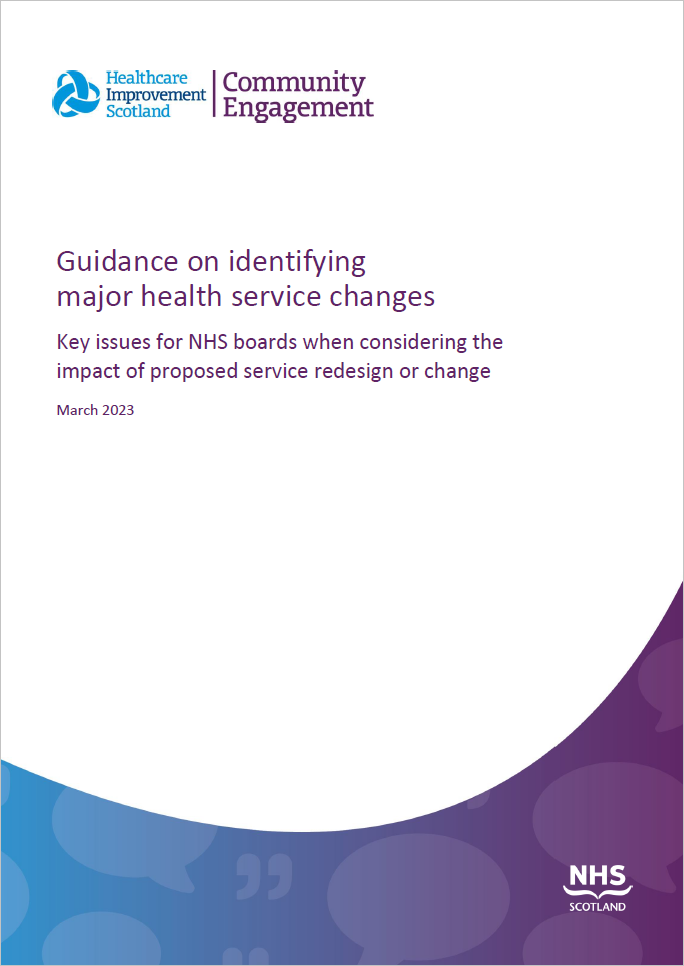Key issues for NHS boards when considering the impact of proposed service redesign or change
This guidance provides NHS boards, and their communities, with a framework that will help them to identify potentially major service changes. It will help boards to carry out a conversation with key stakeholders in order to agree a consensus view. Our Service Change Team can advise on using this guidance.
The following issues should be considered when identifying whether a proposed service change should be regarded as major. They are not ranked in order of importance. Some issues may appear to overlap, but each should be considered. Any evaluation as to what extent these issues apply will involve a level of subjectivity.
NHS boards and other stakeholders (such as Scottish Government, community representatives and elected members) should consider each issue along with local circumstances. As a general rule, the more issues that apply, the more likely it is that a service change should be considered as major. The prompts under each heading are not intended to be exhaustive. NHS boards should consider what evidence they have from their engagement to date and whether they are at the right stage in the process to complete the major service change template.
1. Impact on patients and carers
- Consider the number of people that will be affected as a proportion of the local population, and assess the likely level of impact on patients, together with any consequential impact on their carers, for example length of hospital stay.
- Where it appears that a relatively small number of people are affected, it may still be necessary to consider the level of impact on those individuals, particularly where their health needs are such that they are likely to require to continue to access the service over a longer period of time.
- The impact of the proposed change on people who may experience discrimination or social exclusion should also be taken into account.
This should be informed by evidence from the equality impact assessment of the proposals and engagement to date with people – for example communities, people with lived experience, staff.
2. Change in the accessibility of services
- Consider whether the proposed change involves relocation, reduction or withdrawal of a service.
- Consider whether the proposed change will result in the closure of a hospital or care facility.
- Assess the likely impact of the proposed change in terms of transport in relation to patients, carers, staff, goods / supplies.
This should be informed by evidence from the equality impact assessment of the proposals, any assessment of transport and access issues, and engagement to date with people – for example communities, people with lived experience, staff.
3. Emergency or unscheduled care services
- Consider whether the proposals involve, or are likely to have a significant impact on, emergency or unscheduled care services, such as Accident and Emergency, Out-of-Hours or maternity services.
- Assess the potential impact on the delivery of services provided by the Scottish Ambulance Service.
This should be informed by evidence from any assessment of transport and access issues and, if applicable, discussions with the Scottish Ambulance Service.
4. Public or political concern
- Assess the likelihood that the proposals will attract a substantial level of public interest or concern, whether across the local population, or amongst particular patient groups or third sector organisations.
- Take account of any views expressed by local health forums, local community groups, community councils or elected representatives.
- Consider any views reflected in the local media or on social media forums, for example, Facebook.
- Are there likely to be complex evidence issues that could be open to challenge or dispute?
This should be informed by evidence from engagement to date with people – for example communities, people with lived experience and staff, on the development of the proposals.
5. Alignment with national policy or professional recommendations
- Do the proposals align with national policy, for example, National Clinical Strategy for Scotland, which sets out proposals for transformational change in order to provide sustainable health and social care services fit for the future?
- Do the proposals align with specialist clinical group recommendations, for example, National Maternity and Neo-Natal Review?
6. Change in the method of service delivery
- Are changes proposed in relation to practitioner roles?
- Might there be changes in settings, such as moving a service from a hospital to a community setting, or vice versa; or other changes in the care process, for example, moving to ‘one stop clinics’ for services which have traditionally been provided separately: or moving from an inpatient service to day case?
- Has the proposed change been demonstrated to work in other areas? Identify whether there are examples of working models elsewhere, which would help to inform discussions.
7. Financial implications
- Consider in broad terms the level of investment, or savings, associated with the proposed changes.
- Consider assumptions around proposals to disinvest in services.
- Take account of the implications for the NHS boards involved and for other organisations such as Integration Joint Boards, Local Authorities.
8. Consequences for other services
- Assess whether the proposed local service change has emerged from a clinical model developed at a regional or national level.
- Consider any cumulative impacts the proposals could have on decisions about the development or location of other services, for example where there are public concerns on local hospital provision in the future.
- Consider how any vacated space may be used to support local people and the community
- Identify whether the proposals will impact on other NHS boards and Integration Joint Board areas
If the proposals have emerged from a national or regional decision then there should be consideration of the feedback from any local equality impact assessment and engagement to date with people – for example communities, people with lived experience, staff.

